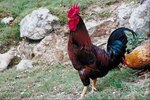
You don't need to keep a rooster in order for a hen to lay eggs. She'll lay them on her own, but they won't be fertilized. For that, a rooster is required. Be prepared -- if you keep a rooster with your hens, every night (and day) becomes a hot time in the hen house. A rooster copulates with his hens several times a day.
Courtship Behavior
Roosters court a hen with a series of ritualistic movements. First, they drop a wing and "dance" around the hen in circle, with the dropped wing held inside. If receptive, the hen lowers her back. The rooster then mounts her, grabbing her by the back of the neck with his beak to steady himself during copulation. However, if a rooster has a lot of hens to service on a daily basis, he might not perform a courtship dance, but get right down to business. The courtship dance might be reserved for a new hen in the flock.
Chicken Copulation
Once the rooster gets himself firmly mounted on the hen, he performs the "tread," sort of walking on his partner's back. Actual copulation occurs when the rooster moves his tail alongside the hen's tail and their cloacas meet. He deposits between 100 million and 5 billion sperm into her vagina, which is just one of the elements of her cloaca. It also serves as the elimination point for urine and feces. As the rooster continues his daily breeding activities, the amount of sperm in his ejaculate decreases.
Chicken Likes and Dislikes
Some hens and roosters just don't like each other and won't copulate. Others are particular favorites and copulate a lot. If you have hens in your flock with heavy feather loss on their backs, poor quality tails and disheveled or missing feathers on the neck, they are probably a rooster's particular playmates. Roosters might even tear open a hen's skin with his nails, which can lead to problems for the bird. Even if the wound is not serious, the sight of a blood in a chicken can lead others in the flock to peck her to death. Remove any wounded hens, keeping them separate from the flock until they recuperate.
What Hens Prefer
A study published in the American Naturalist reveals that hens prefer certain secondary sex characteristics in roosters when given the opportunity to choose a mate. These include comb length -- the trait most important for the hens, who like a longer comb -- dark eyes and plumage. Hens didn't seem to care about the age of a rooster. Researchers concluded that comb length indicates a state of overall good health, so the hens might be making a sort of genetic decision when favoring the long-combed roosters.
References
Photo Credits
-
Jupiterimages/Photos.com/Getty Images
Writer Bio
Jane Meggitt has been a writer for more than 20 years. In addition to reporting for a major newspaper chain, she has been published in "Horse News," "Suburban Classic," "Hoof Beats," "Equine Journal" and other publications. She has a Bachelor of Arts in English from New York University and an Associate of Arts from the American Academy of Dramatics Arts, New York City.




